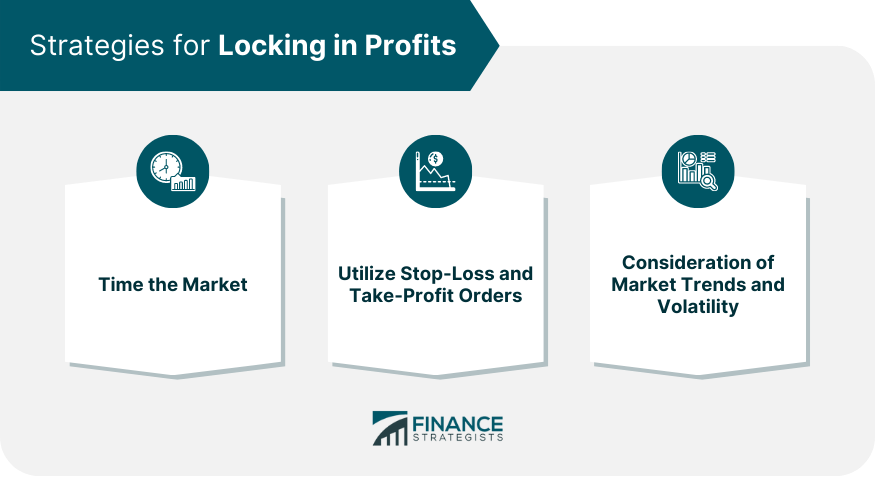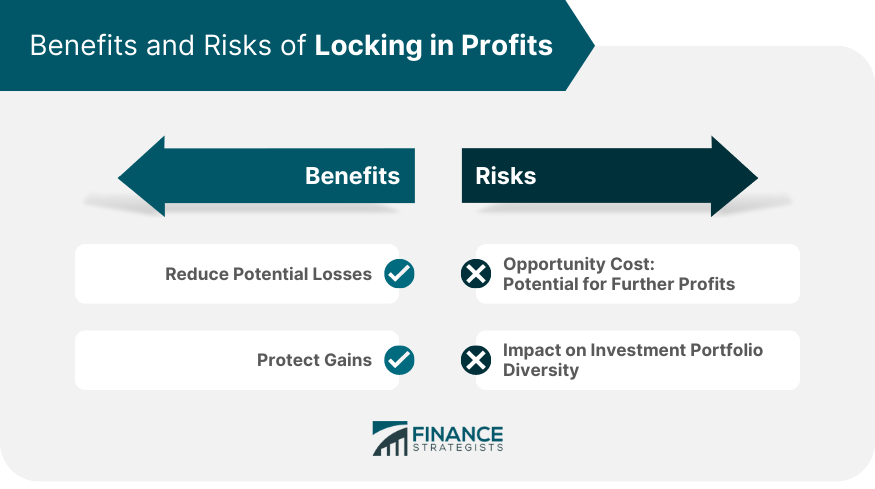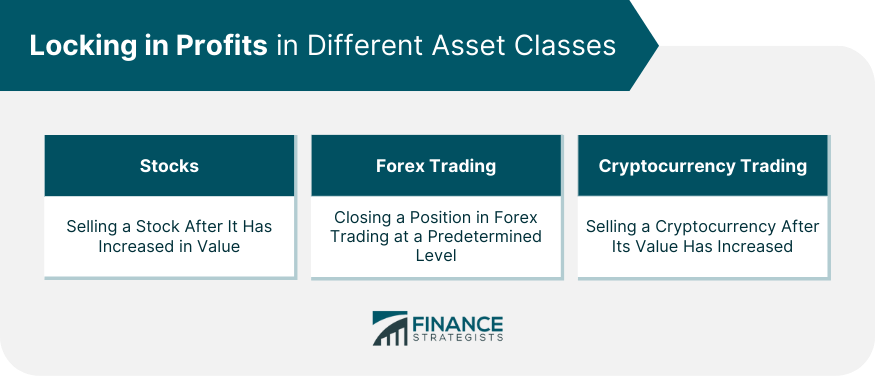Locking in profits is the act of selling security to turn unrealized gains into realized ones. It is done to mitigate risk and secure a positive return on investment. It is also known as "taking money off the table." Unrealized gains are potential profits that an investor would make if they were to sell a security at its current market price. Realized gains are actual profits that an investor makes after selling a security. Locking in profits can be a good strategy for investors who are concerned about market volatility or who want to ensure a positive return on their investment. However, it is important to weigh the risks and benefits of locking in profits before making a decision. In the world of investing, when you buy or sell a security, you're opening a position. If you purchase a stock, for instance, you have an open position in that stock. While this position remains open, any profits or losses are only on paper—they're unrealized. When you sell the security, you're closing the position, and any profits or losses become realized. Locking in profits requires an investor to close their position. This means they must sell the security they currently own. The mechanics are straightforward: an investor places a sell order with their broker, specifying the number of shares (or units) they wish to sell and the price at which they're willing to sell. Once this order is executed, the investor has successfully locked in their profits. Let's consider an example. Suppose an investor purchased 100 shares of Company X at $10 each, investing a total of $1,000. Over time, the share price increases to $15. At this point, the investor's unrealized profit is $500. If the investor decides to sell their shares now, they will lock in this $500 profit. However, if they choose to hold onto their shares and the price falls to $12, their potential profit decreases to $200. This example highlights the risk of not locking in profits when the opportunity presents itself. One of the most common strategies to lock in profits is attempting to time the market, which involves making trading decisions based on predicted price movements. The goal is to buy securities at a low price and sell them at a high price. However, this strategy is risky and challenging, even for seasoned investors. Market trends are often unpredictable and influenced by a variety of factors, making it difficult to consistently time trades accurately. Investors can also use stop-loss and take-profit orders to automatically lock in profits. A stop-loss order is a standing order placed with a broker to sell a security when it reaches a specific price. Similarly, a take-profit order sets the target profit level at which the broker is instructed to close the position. These tools can help investors manage their risk and secure profits without constantly monitoring the market. When deciding whether to lock in profits, investors should consider market trends and volatility. For instance, in a bull market, where prices are generally rising, investors might choose to hold onto their securities longer to maximize their profits. On the other hand, in a volatile market, locking in profits might be a wise decision to avoid potential losses. It's essential for investors to keep abreast of market conditions and adjust their strategies accordingly. By selling security after it has increased in value, investors can secure their gains and minimize the risk of potential losses. This strategy is particularly useful during periods of market volatility when security prices are prone to fluctuations. By locking in profits, investors can safeguard their capital and avoid potential downturns in the market. When investors sell a security that has experienced a price appreciation, they realize the gains they have made. Locking in profits allows investors to capture the value they have gained from their investment. It provides a sense of security by converting paper gains into tangible returns. One of the significant risks of locking in profits is the potential opportunity cost of further profits. If an investor sells a security and it continues to rise in value, they miss out on the additional gains they could have made by holding onto it. This risk is particularly relevant in situations where the market continues to rally or if the security has significant growth potential. Locking in profits by selling security can have implications for the overall diversity of an investor's portfolio. When a security is sold, the investor may reduce their exposure to a particular sector or asset class. This could lead to a less balanced portfolio, potentially exposing the investor to higher risk if the remaining investments are concentrated in a few specific areas. Investor psychology plays a crucial role in the decision to lock in profits. Fear and greed can significantly influence an investor's decisions. Fear of losing unrealized gains can prompt an investor to sell early, while greed can cause them to hold onto security for too long in the hope of higher profits. Every investor has a different risk tolerance and set of investment goals. Some investors may prefer to lock in profits regularly, while others may be more comfortable leaving their positions open in the hope of achieving greater returns. Understanding one's risk tolerance and investment goals is essential when deciding whether to lock in profits. Market sentiment, the overall attitude of investors toward a particular security or financial market, can also affect the decision to lock in profits. During periods of positive market sentiment, investors may be more likely to leave their positions open, while during periods of negative market sentiment, they may be more inclined to lock in profits. Locking in profits in the stock market involves selling a stock after it has increased in value. This can be done manually or through the use of automated trading tools such as stop-loss and take-profit orders. In Forex trading, locking in profits can be achieved by closing a position when a currency pair reaches a certain level. This can be especially useful in the volatile Forex market, where currency values can fluctuate rapidly. Given the highly volatile nature of cryptocurrencies, locking in profits can be a crucial strategy for crypto traders. Similar to other asset classes, this involves selling a cryptocurrency after its value has increased. Locking in profits is a crucial strategy for investors looking to mitigate risk and secure their returns in the financial markets. By selling security and converting unrealized gains into realized ones, investors can protect their capital and potentially reinvest the profits into other opportunities to diversify their portfolio. Strategies for locking in profits include timing the market, utilizing stop-loss and take-profit orders, and considering market trends and volatility. While there are benefits to locking in profits, such as reducing potential losses and protecting gains, there are also risks involved, including the opportunity cost of missing out on further profits and potential impacts on portfolio diversity. Understanding the psychology behind locking in profits, including factors like fear, greed, risk tolerance, investment goals, and market sentiment, is crucial for making informed decisions. However, successfully implementing these strategies can be complex and challenging, especially for individual investors. That's why it is recommended to seek the assistance of professional wealth management services.What Is Locking in Profits?
Mechanism of Locking in Profits
Explaining Open and Closed Positions
Process of Closing a Position to Lock in Profits
Example Scenarios of Locking in Profits
Strategies for Locking in Profits
Timing the Market: Pros and Cons
Utilizing Stop-Loss and Take-Profit Orders
Consideration of Market Trends and Volatility

Benefits of Locking in Profits
Reducing Potential Losses
Protecting Gains
Risks of Locking in Profits
Opportunity Cost
Impact on Investment Portfolio Diversity

Psychology Behind Locking in Profits
Role of Fear and Greed in Decision-Making
Understanding Risk Tolerance and Investment Goals
Influence of Market Sentiment on Locking in Profits
Locking in Profits in Different Asset Classes
Stocks
Forex Trading
Cryptocurrency Trading

Final Thoughts
Locking in Profits FAQs
Locking in profits refers to selling a security after it has increased in value, turning unrealized gains into realized ones.
Locking in profits allows an investor to secure a return on their investment, mitigating potential future losses due to market volatility.
Locking in profits can potentially impact portfolio diversity. When an investor sells a security, they may decrease their exposure to a particular sector or asset class, potentially leading to a less balanced portfolio.
Investor psychology, particularly emotions such as fear and greed, can significantly influence the decision to lock in profits.
Yes, investors can lock in profits in various asset classes, including stocks, Forex, and cryptocurrencies.
True Tamplin is a published author, public speaker, CEO of UpDigital, and founder of Finance Strategists.
True is a Certified Educator in Personal Finance (CEPF®), author of The Handy Financial Ratios Guide, a member of the Society for Advancing Business Editing and Writing, contributes to his financial education site, Finance Strategists, and has spoken to various financial communities such as the CFA Institute, as well as university students like his Alma mater, Biola University, where he received a bachelor of science in business and data analytics.
To learn more about True, visit his personal website or view his author profiles on Amazon, Nasdaq and Forbes.











